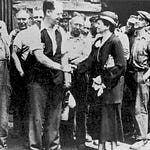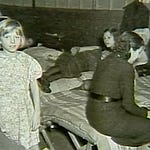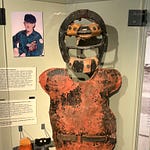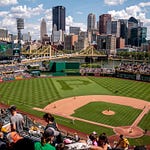When I started poking around for significant historical events in our region that took place in July, I came upon The Great Railroad Strike.
“Huh?”
Same here.
Lately I’ve been diving into railroad history, thanks to a few of my spring motorcycle stops out West. My father’s family worked for the Santa Fe (now part of BNSF) and in a fascinating twist, his family tree contains union men and union busters. I’ll be talking about that in my new series, “Buckskin Rides Again,” beginning July 20.
Here’s what you need to know to crush this month’s quiz.
In the summer of 1877, the nation’s railroads ground to a halt—not because of weather or mechanical failure, but because tens of thousands of workers had had enough. Sparked by wage cuts on the Baltimore & Ohio Railroad in Martinsburg, West Virginia, the Great Railroad Strike quickly spread across the industrial heartland, disrupting cities from Pittsburgh to Chicago.
It was the first major, national labor uprising in U.S. history—an unplanned but powerful response to mounting frustrations over low pay, dangerous conditions, and unchecked corporate power during the Gilded Age.
The roots of the strike stretched back four years to the Panic of 1873, a financial crisis that triggered a long and brutal depression. Railroads overbuilt during boom times and then collapsed into bankruptcy, responding with layoffs, wage cuts, and speedups that made a hard job even harder. With few labor protections and no social safety net, workers were left to fend for themselves in a climate of growing desperation.
This quiz will explore key moments, people, and places involved in the 1877 strike. Don’t worry if you’re not a historian—each question is designed to deepen your understanding while testing what you already know. Think of it as a whistle-stop tour through one of the most pivotal labor movements in American history.
Here’s a quick summary of how it affected states in our 981 Project.
The strike’s legacy in Kentucky is worth a note. In Louisville, where white railroad workers decided not to strike, these workers ended up avoiding pay cuts by siding with the Louisville and Nashville (L&N) Railroad against a general strike by Black workers.
Some white workers even formed their own militia to protect railroad property,” says Shannon M. Smith, a history professor at the College of St. Benedict and St. John’s University who has written about the 1877 strike in Louisville. “So rather than siding with other workers, they sided with the company.”
Note to my fantastic new subscribers:
Monthly trivia is for sport. It’s not a test of intelligence or character. I had to do a significant amount of research before writing this. Do your best and enjoy learning something new.
QUESTIONS
Answers in the footnotes. Good luck.
How did the Panic of 1873 contribute to the conditions that sparked the Great Railroad Strike of 1877? (Select all that apply) 1
A) It led to widespread railroad bankruptcies and aggressive cost-cutting
B) It triggered a long economic depression, increasing unemployment and worker desperation
C) It caused major public investment in rail infrastructure, raising expectations for worker benefits
D) Railroad companies responded with repeated wage cuts and layoffs
E) It hardened public opinion against organized labor and fueled anti-union sentimentWhy didn’t the hardships caused by the Panic of 1873 lead to meaningful protections for railroad workers before the 1877 strike? (Select all that apply)2
A) The federal government had no established system of unemployment relief or labor regulation
B) The Supreme Court prioritized contract rights and property over collective labor action
C) Business leaders promoted the idea that free-market forces—not laws—should determine wages and conditions
D) Most state governments remained neutral, refusing to intervene in labor disputes
E) The idea of federal intervention in the economy or social welfare was still politically unpopularWhat specific events in Martinsburg, West Virginia, triggered the beginning of the Great Railroad Strike of 1877? (Select all that apply)3
A) The B&O Railroad announced another round of wage cuts during an ongoing economic depression
B) Workers were outraged by the hiring of Chinese immigrant labor to replace striking crews
C) Freight trains were made longer, increasing workload and danger without additional pay
D) Local militia forces refused to use violence against the strikers, prompting calls for federal troops
E) Strike leaders issued a coordinated call for national labor action from MartinsburgWhy were railroad companies able to maintain poor working conditions with little pushback before 1877? (Select all that apply)4
A) There were few or no labor laws regulating work conditions
B) Railroads had powerful allies in government and media
C) Workers feared arrest or blacklisting if they organized
D) Most legal decisions favored company property rights over worker protections
E) The country was recovering from a financial panic and jobs were scarceWhich of the following accurately describes the leadership and ideology behind the Great Railroad Strike of 1877? (Select all that apply)5
A) The strike was organized and led by the Industrial Workers of the World (IWW)
B) European anarchist groups coordinated protests in multiple cities
C) The strike was largely spontaneous, with no centralized leadership
D) Local working-class communities often joined in, even if they weren’t railroad employees
E) The strike laid early groundwork for future labor organizing in the U.S.What were some of the longer-term effects of the Great Railroad Strike of 1877 on labor organizing in the United States? (Select all that apply)6
A) It led directly to the founding of the Industrial Workers of the World (IWW)
B) It exposed the need for more coordinated labor action, spurring the growth of groups like the Knights of Labor
C) It inspired future protests and strikes, including the 1886 Haymarket Affair in Chicago
D) It demonstrated that spontaneous uprisings could succeed without any formal organization or ideology
E) It contributed to public fears of radicalism, prompting crackdowns on labor and immigrant communitiesWhich of the following are true about the Baltimore & Ohio Railroad (B&O), the company at the center of the 1877 strike? (Select all that apply)7
A) It was one of the earliest railroads in the U.S., created to help Baltimore compete with New York’s Erie Canal
B) Its route followed the Ohio River to connect eastern cities with expanding markets in the Midwest
C) It was financed in part by the city of Baltimore, which held early stock in the company
D) The railroad carried both passengers and freight, including coal, grain, and manufactured goods
E) It played a strategic role in the Civil War, carrying Union troops and suppliesFraternal organizations (like the Freemasons, Odd Fellows, and Knights of Pythias) were everywhere in the 19th century and sometimes overlapped with working-class networks. Their mutual aid models later influenced the structure of labor unions and workers' benefit societies. What role did fraternal organizations (e.g., Freemasons, Odd Fellows, Knights of Pythias) play in the Great Railroad Strike of 1877? (Select all that apply)8
A) They organized secret meetings to plan strike actions across state lines
B) They mostly stayed on the sidelines, focusing on charity and social order
C) Their networks sometimes helped strikers quietly, but not officially
D) Their emphasis on mutual aid influenced the structure of future labor unions
E) They acted as formal mediators between railroad executives and strikersWhich of the following are true about the Knights of Labor, one of the earliest national labor organizations in the U.S.? (Select all that apply)9
A) They accepted both skilled and unskilled workers, including women and Black workers
B) They were a secret society at first, but later grew into a mass movement
C) They limited membership to railroad workers only
D) They played a major role in organizing during the Great Railroad Strike of 1877
E) They promoted the eight-hour workday and cooperative ownership of businessesWhat made the violence in Pittsburgh during the Great Railroad Strike of 1877 especially significant? (Select all that apply)10
A) Local militia refused to take action, so the Pennsylvania National Guard was brought in from another city
B) Troops opened fire on strikers and bystanders, killing at least 20 people
C) Enraged citizens responded by setting fire to railroad property, including cars and roundhouses
D) The city’s business leaders paid the militia directly for protection services
E) The event exposed class divisions not only between workers and owners, but between different cities and communities
Movie Trailer Intermission
I’m going “off topic” here but stay with me. While I rarely go to theaters for movies these days, I made two exceptions over the holiday weekend.
First up, This is Spinal Tap, which I saw back in the day (1984). It’s where “turn it up to eleven” originated, kids. I believe it’s the first “mocumentary” but some call it a “rockumentary” because it follows an English rock-n-roll/heavy metal band on its American tour.
Matt and I were in a theater full of fellow grayhairs, laughing until we cried—while also cringing at the casual misogyny baked into the script and lyrics. It’s a weird emotional split, holding both the hilarity and the discomfort. But we humans are built for contradiction. We do it all the time. On limited release through August 7, just in time for the September release of Spinal Tap II: The End Continues.
Next, F1, which is great storytelling. The only exception I take is the romance trope Hollywood can’t seem to resist. I can’t be giving anything away—it’s telescoped in the trailer, for heaven’t sake.
✅ A) It led to widespread railroad bankruptcies and aggressive cost-cutting
✅ B) It triggered a long economic depression, increasing unemployment and worker desperation
❌ C) It caused major public investment in rail infrastructure, raising expectations for worker benefits (sounds plausible but not accurate—public support was limited during the panic)
✅ D) Railroad companies responded with repeated wage cuts and layoffs
✅ E) It hardened public opinion against organized labor and fueled anti-union sentiment
✅ A) The federal government had no established system of unemployment relief or labor regulation
✅ B) The Supreme Court prioritized contract rights and property over collective labor action
✅ C) Business leaders promoted the idea that free-market forces—not laws—should determine wages and conditions
❌ D) Most state governments remained neutral, refusing to intervene in labor disputes (False—many did intervene, and often sided with employers or used force)
✅ E) The idea of federal intervention in the economy or social welfare was still politically unpopular
✅ A) The B&O Railroad announced another round of wage cuts during an ongoing economic depression
❌ B) Workers were outraged by the hiring of Chinese immigrant labor to replace striking crews (This was more typical on the West Coast later; not central to Martinsburg). While Chinese immigrant labor did become a major source of tension in 19th-century labor disputes—especially in California and the Mountain West—those dynamics were not central to the events in Martinsburg. The early B&O workforce was overwhelmingly white and native-born, and the 1877 strike was driven more by wage cuts, overwork, and lack of labor protections than by fears of replacement by immigrant labor.
✅ C) Freight trains were made longer, increasing workload and danger without additional pay
✅ D) Local militia forces refused to use violence against the strikers, prompting calls for federal troops
❌ E) Strike leaders issued a coordinated call for national labor action from Martinsburg (The strike spread without centralized leadership or planning)
✅ A) There were few or no labor laws regulating work conditions
✅ B) Railroads had powerful allies in government and media
✅ C) Workers feared arrest or blacklisting if they organized
✅ D) Most legal decisions favored company property rights over worker protections
✅ E) The country was recovering from a financial panic and jobs were scarce
❌ A) The strike was organized and led by the Industrial Workers of the World (IWW) (The IWW didn’t exist until 1905)
❌ B) European anarchist groups coordinated protests in multiple cities (No evidence of this; anarchist influence came later)
✅ C) The strike was largely spontaneous, with no centralized leadership
✅ D) Local working-class communities often joined in, even if they weren’t railroad employees
✅ E) The strike laid early groundwork for future labor organizing in the U.S.
❌ A) It led directly to the founding of the Industrial Workers of the World (IWW) the following year (The IWW wasn’t founded until 1905 and wasn’t a direct outcome)
✅ B) It exposed the need for more coordinated labor action, spurring the growth of groups like the Knights of Labor
✅ C) It inspired future protests and strikes, including the 1886 Haymarket Affair in Chicago
❌ D) It demonstrated that spontaneous uprisings could succeed without any formal organization or ideology (It showed the limits of spontaneity—no lasting gains were won)
✅ E) It contributed to public fears of radicalism, prompting crackdowns on labor and immigrant communities
✅ A) It was one of the earliest railroads in the U.S., created to help Baltimore compete with New York’s Erie Canal
✅ B) Its route followed the Ohio River to connect eastern cities with expanding markets in the Midwest
❌ C) It was financed in part by the city of Baltimore, which held early stock in the company (Close, but technically the city loaned funds and invested—some truth, but not quite in the form implied here)
✅ D) The railroad carried both passengers and freight, including coal, grain, and manufactured goods
✅ E) It played a strategic role in the Civil War, carrying Union troops and supplies
❌ A) They organized secret meetings to plan strike actions across state lines (No historical evidence of this)
✅ B) They mostly stayed on the sidelines, focusing on charity and social order
✅ C) Their networks sometimes helped strikers quietly, but not officially
✅ D) Their emphasis on mutual aid influenced the structure of future labor unions
❌ E) They acted as formal mediators between railroad executives and strikers (They did not play that public or political role)
✅ A) They accepted both skilled and unskilled workers, including women and Black workers
✅ B) They were a secret society at first, but later grew into a mass movement
❌ C) They limited membership to railroad workers only (They welcomed workers from many trades)
❌ D) They played a major role in organizing during the Great Railroad Strike of 1877 (They were not central to that strike; their influence grew afterward)
✅ E) They promoted the eight-hour workday and cooperative ownership of businesses
✅ A) Local militia refused to take action, so the Pennsylvania National Guard was brought in from another city
✅ B) Troops opened fire on strikers and bystanders, killing at least 20 people
✅ C) Enraged citizens responded by setting fire to railroad property, including cars and roundhouses
❌ D) The city’s business leaders paid the militia directly for protection services (False—militia were state-funded, though business pressure played a role)
✅ E) The event exposed class divisions not only between workers and owners, but between different cities and communities
Before the National Guard (federally standardized in 1903), state and local militias were the go-to force for controlling unrest. These groups were often composed of local white men with civic or business ties, and they answered to mayors or governors—not federal authorities.
In cities like Pittsburgh, this got complicated fast:
When the local militia refused to turn weapons on their neighbors, the state brought in a militia from Philadelphia—men with no community ties and no hesitation to use violence.
This wasn’t an isolated case. Across the Gilded Age, state militias were deployed against striking workers, not to mediate but to suppress. Funding came from state coffers, but the push to act often came from railroads and industrialists, who used their political influence to demand “order.”
Understanding how state-funded militias enforced economic hierarchy—and how their loyalties could shift with geography or class—offers a lens into modern conflicts over protest policing, privatized security, and state violence. The Gilded Age didn’t just shape labor law. It shaped how power shows up with a badge, a rifle, or a budget line.
Recommended Reading
Title: The 1877 Strike That Brought US Railroads to a Standstill
Source: History.com
Why it helps: This piece discusses the impact of militia deployment on both worker communities and emerging police forces, including the construction of armories in working-class neighborhoods—highlighting the direct line from 19th‑century class enforcement to today’s debates over militarized response to protest .












